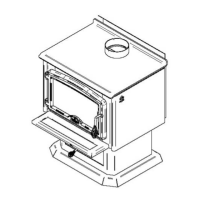Page 23
Installation and Operation Manual - 2000
ENGLISH
Therefore, allow each load of wood to burn down so that the space begins to cool off a little
before loading. Letting the space cool before loading is one of the secrets to clean burning and
effective zone heating.
4.6.5 Controling the Air Supply
Once the firewood, firebox and chimney are hot, you can begin to reduce the air supply for a
steady burn.
As you reduce the air supply to the fire, two important
things happen. First, the firing rate slows down to
spread the heat energy in the fuel over a longer period
of time. Second, the flow rate of exhaust through the
stove and flue pipe slows down, which gives more time
for the transfer of heat from the exhaust. You will notice
that, as you reduce the air setting, the flames slow
down. This is your indication that the stove is burning
at its peak efficiency.
If the flames get small and almost disappear when
you turn down the air, you have turned down the air
too early, or your firewood is wetter than it should be.
With good fuel and correct air control use, the flames
should slow down, but should stay large and steady,
even as the air supply is reduced.
Figure 17: Air Supply Control
4.7 Building Different Fires for Different Needs
Using the air control is not the only way to match the stove’s heat output to the heat demand.
Your house will need far less heat in October than in January to be kept at a comfortable
temperature. If you fill the firebox full in fall weather, you will either overheat the space or turn
the stove down so much that the fire will be smoky and inefficient. Here are some suggestions
for building fires to match different heat demand.
4.7.1 Small Fires to Take the Chill Off the House
To build a small fire that will produce a low heat output, use small pieces of firewood and load
them crisscross in the firebox. The pieces should be only 3" to 4" in diameter. After raking the
coals, you can lay two pieces parallel to each other corner to corner in the firebox and lay two
more across them in the other direction. Open the air control fully and only reduce the air after
the wood is fully flaming. This kind of fire is good for mild weather when you are around to tend
the stove and should provide enough heat for four hours or more. Small fires like this are a good
time to use softer wood species so there will be less chance of overheating the house.
4.7.2 Long Lasting Low Output Fires
Sometimes you will want to build a fire to last up to eight hours, but don’t need intense heat. In
this case use soft wood species and place the logs compactly in the firebox so the pieces are
packed tightly together. You will need to fire the load hot for long enough to fully char the log
surfaces before you can turn the air down. Make sure the fire is flaming brightly before leaving
the fire to burn.

